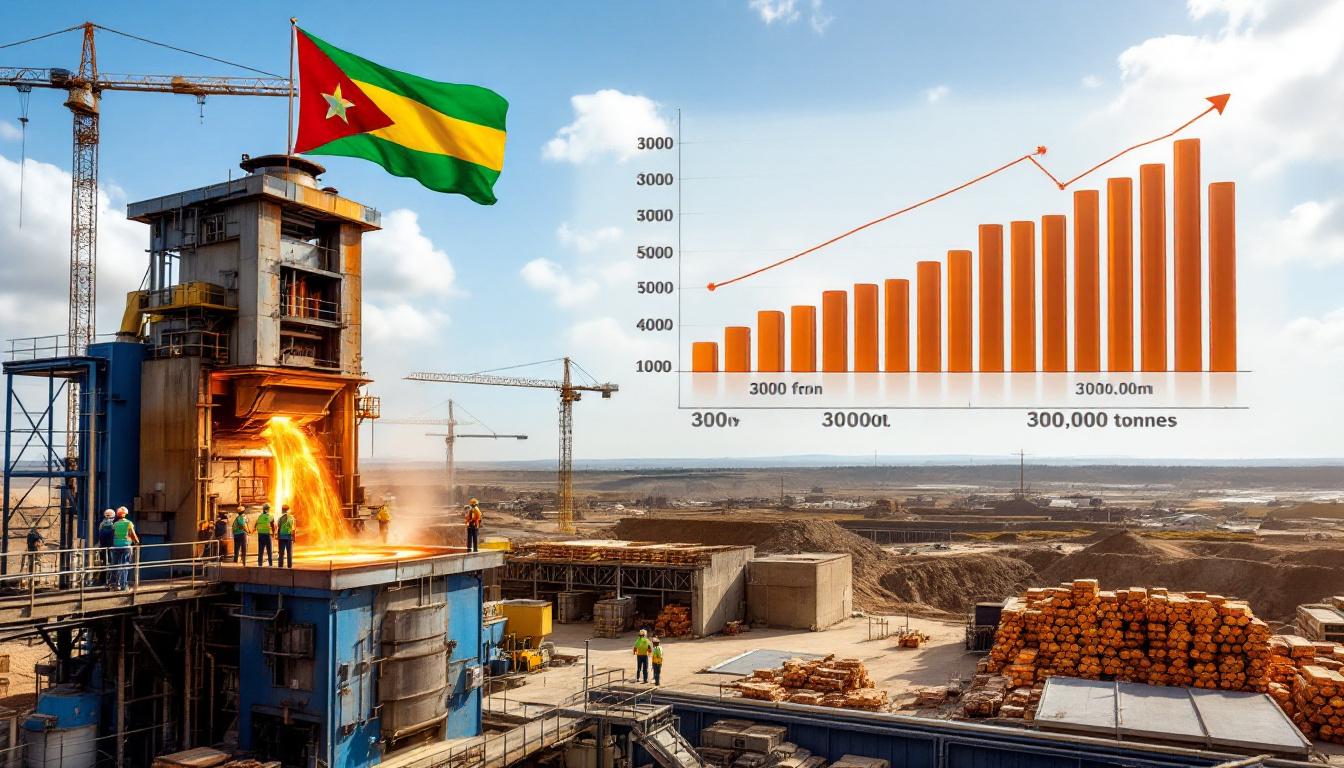The Market Impact: How ADP Employment Data Pushed Copper Prices Past $10,000
The intricate relationship between economic indicators and commodity markets took center stage on July 3, 2025, when unexpected employment data triggered significant movements in global copper prices. This analysis explores how weak US labor figures contributed to copper breaking the psychological $10,000 threshold and examines the broader implications for industrial metals.
What Happened to ADP Employment Data?
Surprising Decline in US Employment Numbers
The private payroll processor ADP reported an unexpected decrease of 33,000 jobs in its latest employment report, falling dramatically below market expectations of 95,000 job additions. This represents the largest employment drop since March 2023, sending shockwaves through financial markets.
"The labor market hasn't merely stalled—it's showing signs of meaningful deterioration for the first time in over two years," noted market analysts tracking the data. This sharp reversal came after several months of slowing but still positive job growth, catching many economists off-guard.
The magnitude of the miss—128,000 jobs below consensus forecasts—raised immediate concerns about the broader US economic outlook. Employment data typically serves as a lagging indicator, suggesting that economic weakness may have been developing beneath the surface for months.
Economic Implications of Weak Labor Data
The disappointing ADP figures prompted immediate recalibration of market expectations for Federal Reserve policy. Traders rapidly increased bets on at least two interest rate cuts before year-end 2025, with futures markets pricing in a 75% probability of the first cut coming by September.
This employment decline suggests potential broader weakness in the US economy that could extend beyond the labor market. Consumer spending, which accounts for approximately 70% of US economic activity, typically weakens when employment trends deteriorate, potentially triggering a negative feedback loop.
The timing is particularly concerning as it coincides with persistent inflation in certain sectors, creating a challenging environment for policymakers navigating between price stability and employment mandates.
How Did Copper Markets React to the ADP Data?
LME Copper Price Movements
London Metal Exchange (LME) copper demonstrated remarkable resilience despite the concerning economic data. Opening at a relatively modest $9,948 per metric ton, prices climbed steadily throughout the trading session, eventually reaching a significant high of $10,020.50/mt before settling at $10,010/mt—marking a 0.67% increase.
The trading volume reached 17,000 lots while open interest stood at 285,000 lots, indicating substantial market participation. This session marked a critical technical breakthrough as copper successfully pushed through the psychologically important $10,000/mt barrier.
Market participants noted that the price action contradicted typical patterns seen during weak economic data releases. Historically, poor employment figures often trigger immediate selloffs in industrial metals like copper, which are sensitive to economic growth expectations.
SHFE Copper Price Performance
Chinese copper futures mirrored the strength seen in London markets. The most-traded Shanghai Futures Exchange (SHFE) copper contract for August delivery (2508 contract) opened at 80,560 yuan/mt and experienced notable volatility during early trading hours.
After touching an intraday high of 80,990 yuan/mt, the contract settled at 80,900 yuan/mt, representing a 0.35% gain from the previous session. Trading activity was robust with volume reaching 36,000 lots and open interest at 225,000 lots.
The synchronized upward movement across both major global copper exchanges highlighted the strength of the underlying trend, with traders seemingly looking past immediate economic concerns.
Why Are Copper Prices Rising Despite Economic Concerns?
Macroeconomic Factors Supporting Copper
Several macroeconomic developments created a supportive environment for copper prices despite the concerning employment data:
-
Dollar Weakness: The US dollar index continued its downward trend, making dollar-denominated commodities like copper more affordable for holders of other currencies. This weakness stemmed from both the expanding US debt scale and mounting concerns about economic slowdown.
-
Anticipated Monetary Easing: The increased likelihood of Federal Reserve rate cuts typically benefits commodity markets through multiple channels—lowering financing costs for physical inventory, reducing opportunity costs for non-yielding assets, and potentially stimulating economic activity.
-
Easing Trade Tensions: A newly announced trade agreement between the United States and Vietnam reduced previously planned tariffs on Vietnamese exports. This development alleviated market concerns about escalating global trade disruptions that could have impacted metal demand.
"With the increasing downward pressure on the US economy and the continuous expansion of the US debt scale, the US dollar index was weak, which is bullish for copper prices," noted commodity analysts at Shanghai Metal Market.
Supply-Side Dynamics in the Copper Market
Beneath the headline-grabbing macroeconomic factors, important supply-side developments provided additional support for copper prices:
-
Market Manipulation Concerns: Unusual trading patterns emerged with evidence of suppliers driving down prices temporarily to facilitate lower-cost purchasing—a practice that paradoxically supported the market's underlying strength.
-
Regional Supply Shortages: A pronounced shortage pattern developed in the Changzhou region of China, creating localized price premiums and supply constraints that rippled through the broader market.
-
Limited Production Response: Despite higher prices, copper producers have shown reluctance to significantly expand output due to persistent concerns about permitting challenges, water scarcity in key mining regions, and declining ore grades at major projects.
These supply constraints provided a counterbalance to potential demand weakness, helping explain copper's resilience in the face of concerning economic data. Furthermore, current global copper supply challenges continue to underpin market fundamentals.
What's Happening with Copper Demand?
Current Demand Patterns
The elevated price environment has created complex demand dynamics across copper-consuming sectors:
-
Price Sensitivity: With copper trading above the $10,000/mt threshold, price-sensitive downstream consumers have shown increasing reluctance to build inventories, preferring just-in-time purchasing strategies.
-
Regional Manufacturing Disparities: Copper rod factories in China's Jiangsu and Zhejiang provinces displayed notably negative purchasing sentiment, with many facilities undertaking scheduled maintenance rather than operating at full capacity.
-
Geographic Variations: In contrast to weakening demand in traditional manufacturing hubs, transaction activity in Changzhou remained relatively robust due to the localized supply shortage, creating a notable geographic divergence in market conditions.
The prevailing high price environment has generally suppressed overall downstream purchasing enthusiasm, with many consumers operating in wait-and-see mode as they monitor both economic indicators and price trends.
Regional Market Differences
The uneven nature of copper demand has created notable regional disparities:
-
Changzhou Outperformance: The Changzhou market maintained relatively stronger transaction volumes compared to neighboring regions, primarily due to localized supply constraints rather than robust end-user demand.
-
Supply Chain Reconfiguration: Some manufacturers have begun exploring alternative supply routes and sourcing strategies to address regional imbalances, including importing cathode from overseas rather than relying on domestic supply chains.
-
Sector-Specific Variations: While construction-related copper demand has weakened significantly, electrical grid infrastructure and renewable energy projects continue to maintain relatively steady consumption patterns.
These regional differences highlight the increasingly fragmented nature of copper markets, where supply chain disruptions and localized factors can create significant price variations even within relatively compact geographic areas.
What's the Outlook for Copper Prices?
Short-Term Price Projections
Despite economic headwinds, copper prices appear positioned to maintain their upward momentum in the near term:
-
Technical Momentum: Breaking through the psychologically important $10,000/mt level typically attracts technical buyers and momentum-based trading strategies.
-
Currency Support: Continued weakness in the US dollar is likely to provide ongoing support for copper valuations as the Federal Reserve shifts toward a more accommodative monetary stance.
-
Supply Constraints: Persistent tightness in physical supply chains, particularly in key Asian manufacturing regions, should help offset potential demand weakness from broader economic slowdown.
Analysts project copper prices to potentially test the $10,200-$10,300/mt range in the coming weeks, contingent on forthcoming economic data and central bank communications. Recent copper price prediction models support this bullish outlook despite macroeconomic uncertainties.
Factors to Monitor for Price Direction
Market participants should closely track several key variables that could influence copper's trajectory:
-
US Employment Trends: The upcoming Bureau of Labor Statistics nonfarm payroll report will provide crucial validation or contradiction of the ADP data, as reported by ADP Employment Report.
-
Federal Reserve Communications: Speeches and minutes from Fed officials will offer insights into how quickly the central bank might pivot toward easing.
-
Chinese Stimulus Measures: Any announcements of infrastructure spending or property market support from Chinese authorities could significantly boost copper demand expectations.
-
Inventory Levels: Monitoring LME and SHFE warehouse stocks will provide early warning of any meaningful shift in the physical supply-demand balance.
-
Energy Transition Policies: Government initiatives supporting electric vehicles, grid modernization, and renewable energy continue to represent a structural demand driver for copper.
The interplay between these factors will determine whether copper can sustain its break above $10,000 or if economic concerns eventually trigger a corrective pullback. Meanwhile, copper investment trends continue to evolve as market conditions shift.
How Do Weak Employment Numbers Affect Commodity Markets?
Relationship Between Labor Data and Commodity Prices
Employment figures impact commodity markets through multiple, sometimes contradictory channels:
-
Demand Signal: Weak employment typically signals reduced industrial activity and consumer spending, which would normally pressure commodity prices downward through anticipated demand destruction.
-
Monetary Policy Response: However, poor labor data increases the likelihood of interest rate cuts, which generally supports commodity prices through currency effects and lower financing costs.
-
Market Psychology: Employment data influences investor risk appetite, with deteriorating labor markets sometimes triggering a flight from cyclical assets like industrial metals.
-
Forward-Looking Assessment: Sophisticated investors attempt to determine whether weak employment represents a temporary slowdown or the beginning of a more significant economic contraction.
Copper's status as both an industrial metal and a macroeconomic bellwether makes it particularly sensitive to employment trends, with price reactions often reflecting the market's collective judgment about which factors will predominate.
Impact on Monetary Policy Expectations
The unexpectedly weak ADP employment data fundamentally altered the interest rate outlook:
-
Rate Cut Probability: Traders rapidly increased bets on at least two Federal Reserve interest rate reductions before year-end, with futures markets pricing a 75% chance of the first cut by September.
-
Dollar Impact: These shifting expectations immediately pressured the US dollar, creating a supportive environment for dollar-denominated commodities like copper.
-
Liquidity Considerations: Anticipated rate cuts typically improve financial market liquidity, often directing investment flows toward physical assets as inflation hedges.
-
Economic Stimulus Effect: Beyond direct currency effects, lower interest rates are designed to stimulate economic activity, potentially offsetting the negative demand implications of weak employment.
This complex interplay between economic data, monetary policy, and market psychology helps explain copper's seemingly counterintuitive strength despite concerning employment figures. Recent copper investment insight provides additional context for this market behavior.
FAQ About ADP Data and Copper Markets
What is ADP employment data?
ADP employment data is a monthly report produced by Automatic Data Processing, Inc. that measures the change in private sector employment in the United States. Released typically two days before the official Bureau of Labor Statistics (BLS) employment report, the ADP data serves as an important preview of labor market conditions. While its methodology differs from the government's approach, investors closely monitor it for early signals about economic health.
Why does copper price react to employment data?
Copper prices react to employment data through multiple mechanisms. First, as an industrial metal widely used across manufacturing, construction, and electronics, copper demand is directly influenced by economic activity levels that employment data helps predict. Second, labor market conditions significantly impact Federal Reserve monetary policy decisions, which affect currency values and financing costs for commodity trading. Finally, as copper is often considered a leading economic indicator itself, traders position based on how employment trends might signal future economic directions.
What does breaking $10,000 mean for copper markets?
The $10,000 per metric ton level represents a significant psychological threshold for copper markets. Breaking this barrier indicates robust bullish sentiment and often triggers technical buying patterns as momentum-focused traders enter positions. Historically, sustained trading above this level has signaled tight physical market conditions and strong investment flows. The breakthrough also attracts media attention, potentially drawing retail investor interest and creating a self-reinforcing price momentum until fundamental factors reassert themselves.
How do regional supply shortages affect global copper prices?
Regional supply shortages impact global copper prices through several mechanisms. Initially, localized shortages create price premiums in affected areas, incentivizing traders to redirect material from other regions. This arbitrage activity can tighten previously balanced markets elsewhere. Additionally, regional shortages often signal broader supply chain disruptions that might eventually affect global availability. Market participants frequently interpret localized tightness as early warning signs of wider supply constraints, bidding up futures contracts in anticipation of spreading shortages.
Further Exploration
Readers interested in learning more about copper market dynamics and economic indicators can also explore related educational content, such as Shanghai Metal Market's daily market updates and analysis at https://www.metal.com/.
Want to Spot the Next Major Mineral Discovery?
Discovery Alert's proprietary Discovery IQ model instantly notifies investors of significant ASX mineral discoveries, converting complex data into actionable insights for both short-term traders and long-term investors seeking substantial returns. Explore how historic discoveries have generated remarkable market returns by visiting the Discovery Alert discoveries page.




